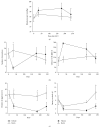Statins Promote Long-Term Recovery after Ischemic Stroke by Reconnecting Noradrenergic Neuronal Circuitry
- PMID: 26448880
- PMCID: PMC4581556
- DOI: 10.1155/2015/585783
Statins Promote Long-Term Recovery after Ischemic Stroke by Reconnecting Noradrenergic Neuronal Circuitry
Abstract
Inhibitors of HMG-CoA reductase (statins), widely used to lower cholesterol in coronary heart and vascular disease, are effective drugs in reducing the risk of stroke and improving its outcome in the long term. After ischemic stroke, cardiac autonomic dysfunction and psychological problems are common complications related to deficits in the noradrenergic (NA) system. This study investigated the effects of statins on the recovery of NA neuron circuitry and its function after transient focal cerebral ischemia (tFCI). Using the wheat germ agglutinin (WGA) transgene technique combined with the recombinant adenoviral vector system, NA-specific neuronal pathways were labeled, and were identified in the locus coeruleus (LC), where NA neurons originate. NA circuitry in the atorvastatin-treated group recovered faster than in the vehicle-treated group. The damaged NA circuitry was partly reorganized with the gradual recovery of autonomic dysfunction and neurobehavioral deficit. Newly proliferated cells might contribute to reorganizing NA neurons and lead anatomic and functional recovery of NA neurons. Statins may be implicated to play facilitating roles in the recovery of the NA neuron and its function.
Figures





References
MeSH terms
Substances
LinkOut - more resources
Full Text Sources
Other Literature Sources
Medical

